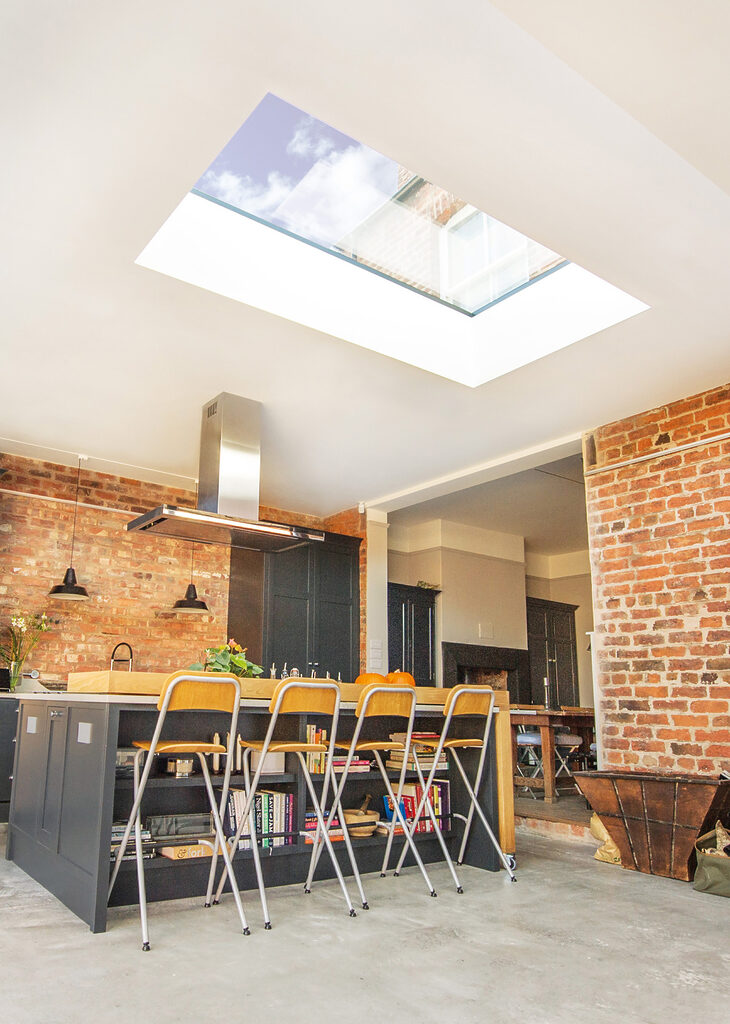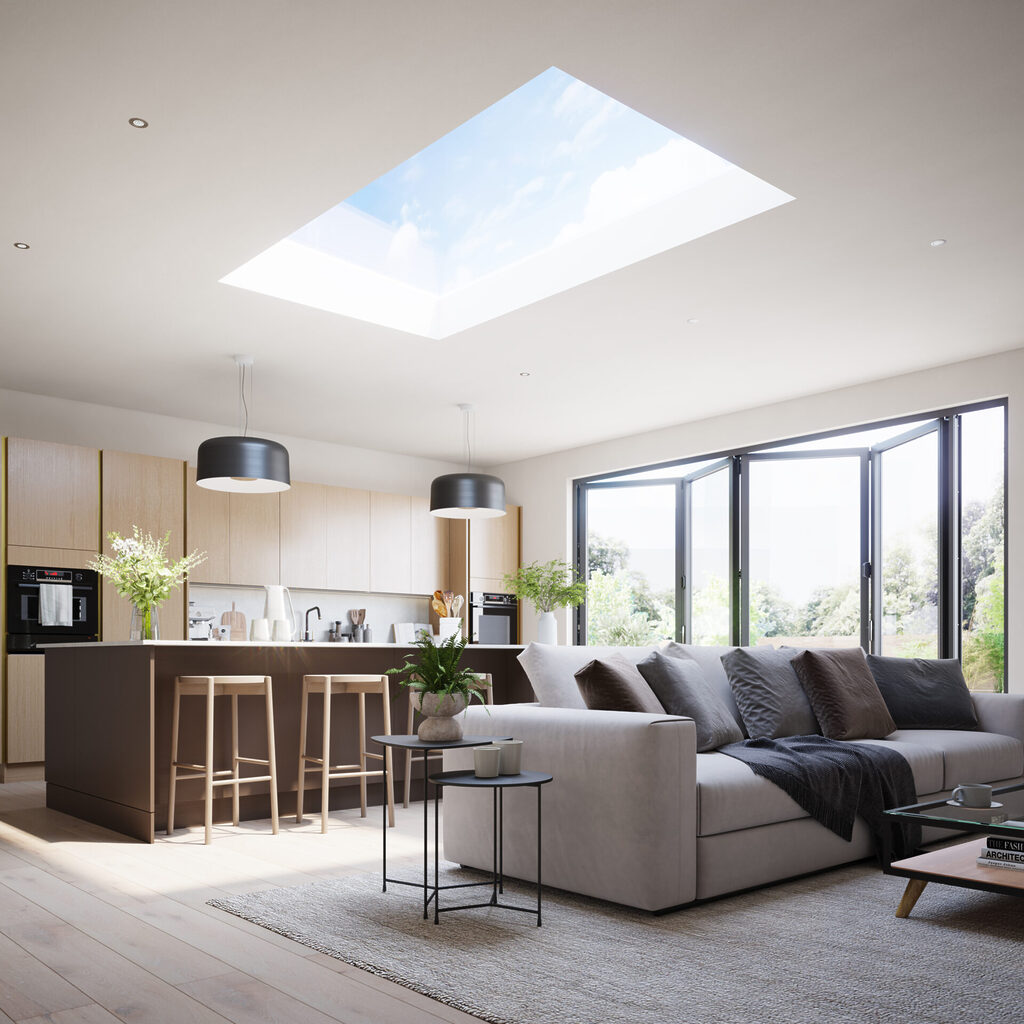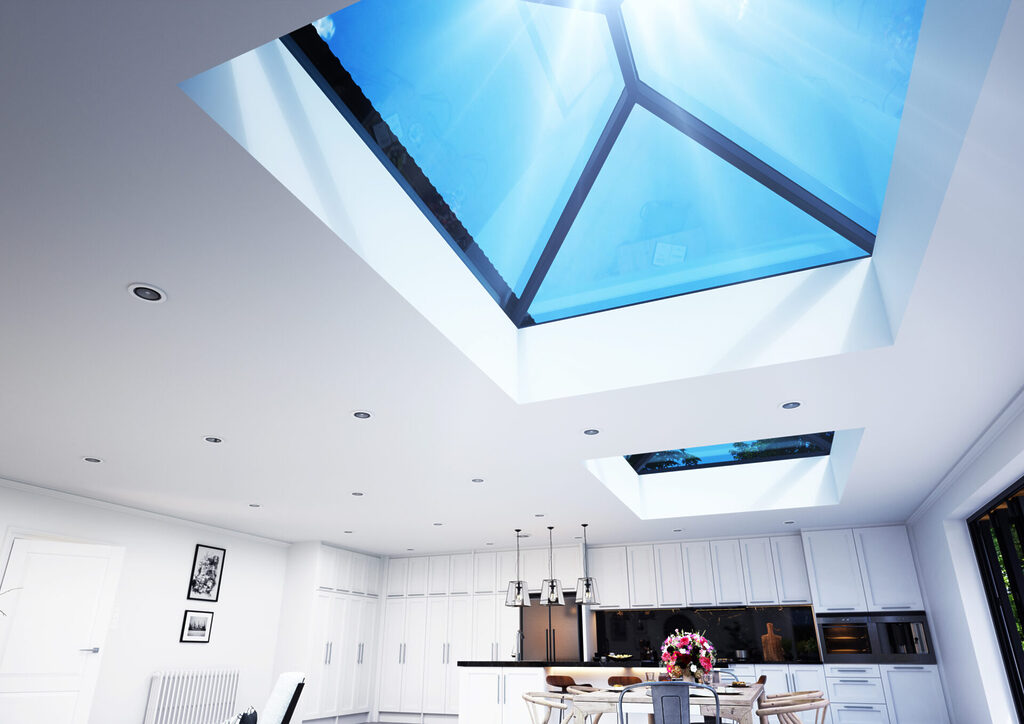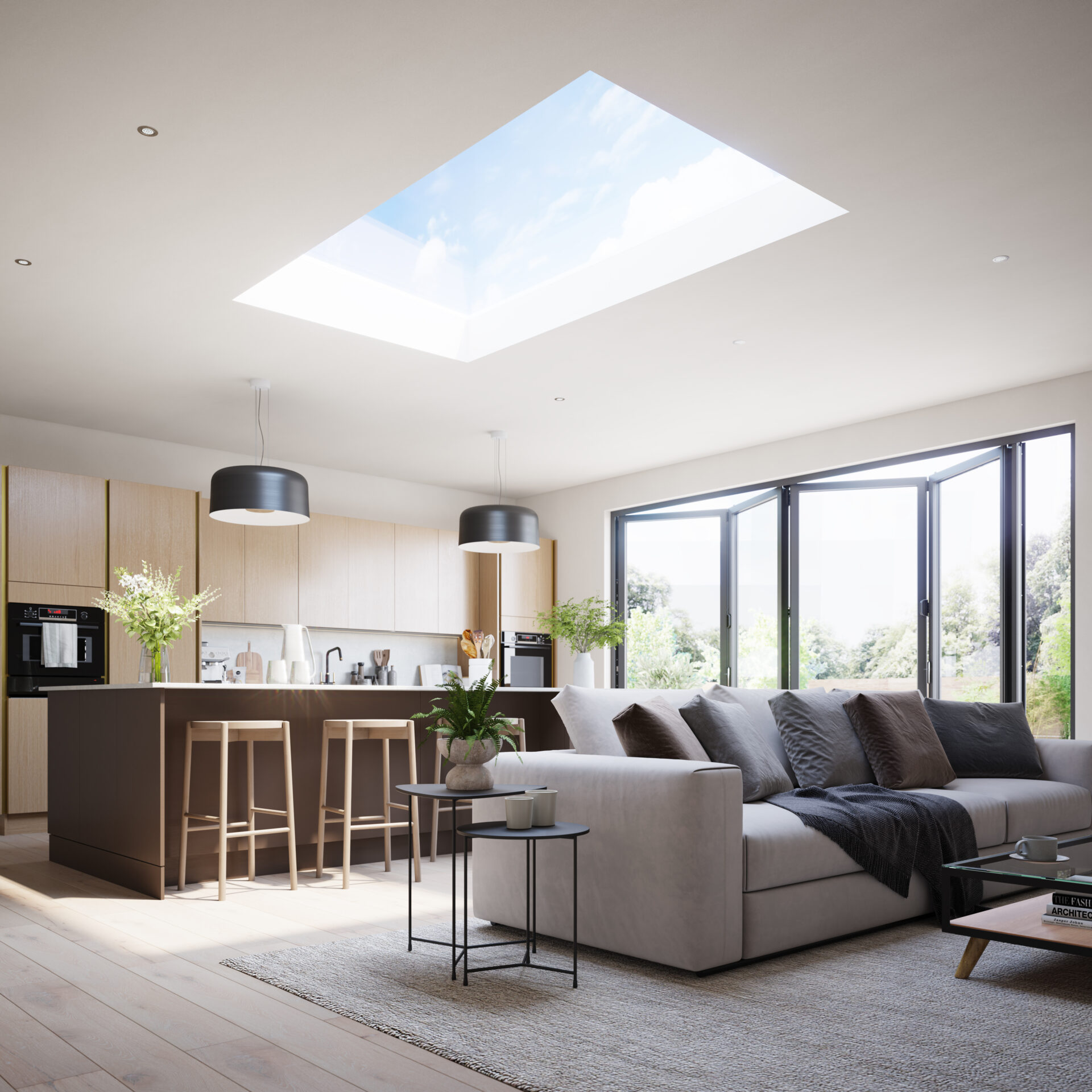Last Updated on 9 December 2024 by Josh Lucas
Roof Lanterns Vs Skylights: Which is best?
Roof lanterns are elevated glass structures that sit on a flat roof to provide natural light, while roof lights are flat or slightly pitched windows installed in the roof. The best choice between the two depends on your specific needs and preferences.
With the popularity of Roof Lights and Lanterns increasing and homeowners now faced with the difficult decision of which one to go for, we’ve created this article to help you decide which one may be best.
Looking for information in a hurry? Jump to:
Roof Lanterns
For those wanting a stunning architectural addition to their home, Roof Lanterns seem to be the easy choice. Not only are they better when it comes to channelling light from all angles, but as a bonus they’re also really good at making the room feel so much bigger. This is down to the fact that they open up the ceiling more towards the sky, causing light flow to maximise and also provide additional height, altering the ergonomics of the room.
When looking closely at Roof Lanterns, you’ll notice that their structure consists of glazed bars, something they’ll always need and rely upon as a support mechanism for the glass. The only issue with Roof Lanterns is that you will always see the glazed bars when you stand underneath it, whereas with Roof Lights, you won’t. A way to get around this can be as simple as opting for lanterns that have minimal glazing bar connectors. This will help to maximise the impact on the look and light that can pass through it.
Related article: what is a roof lantern.
Skylights
If you’d rather not see anything from the outside of the property, Roof Lights (also known as skylights in Europe) may be the one for you as they sit very low to the roof. If you choose one that has been manufactured to the internal dimensions, it’ll allow for much more light to enter the room, usually 25% more light. They instantly and unobtrusively brighten up any extension.
Our Atlas Roof Lights make a stunning addition to any home, with bespoke sizes available too.
10 Key Differences Between Roof Lanterns vs Skylights
Here at the 10 key differences between roof lanterns and skylights:
1. Design and Appearance
Roof Lantern
Roof lanterns are dramatic and elegant, instantly adding an architectural statement to your home. Their raised, pyramid-like structure captures the eye, making them a centerpiece in any room. The framing materials are typically aluminum or uPVC, which offer a modern, sleek finish.
Skylight
In contrast, skylights are designed to be subtle, blending seamlessly with your roof. They’re ideal for modern homes that prioritise clean lines and a minimalist look. With fewer visible frames, skylights let the glass take center stage.
2. Light and Visibility
Roof Lantern
Roof lanterns are unmatched when it comes to maximising light. Because they sit above the roofline, they allow light to enter from multiple angles, creating a bright and airy atmosphere. This makes them ideal for large, open spaces.
Skylight
Skylights, while effective, provide more focused light. This directional lighting works well for smaller areas or spaces that need targeted illumination, like over a dining table or workspace.
3. Aesthetic Impact
Roof Lantern
A roof lantern’s grandeur makes it a show-stopping feature, particularly in extensions or conservatories. The raised design also creates a sense of height, making the room feel larger.
Related article: how to light a roof lantern.
Skylight
Skylights, on the other hand, are understated and modern. They add light without drawing too much attention, making them ideal for spaces where simplicity is key.
4. Installation and Complexity
Roof Lantern
Installing a roof lantern often requires more structural work to accommodate its weight and design, which can make the process more complex compared to skylights. However, modern options like Korniche and Atlas roof lanterns are designed for straightforward installation, featuring innovative systems that minimise assembly time.
Related article: how to fit a roof lantern.
Skylight
Skylights are generally simpler to install due to their flush design, making them a great option for areas where time and budget are limited. As with roof lanterns, many modern skylight systems are engineered for easier installation, including those offered by Korniche and Atlas.

5. Roof Suitability
Roof Lantern
Roof lanterns work best on flat roofs, where their dramatic design can be fully appreciated. While you may find a rare model that can be adapted for pitched roofs, it’s a much more complex process.
Related article: can you put a roof lantern on a pitched roof?
Skylight
Skylights are highly versatile, suitable for both flat and pitched roofs. This makes them a more flexible option for homes with varied architectural styles.
6. Price
Roof Lantern
Surprisingly, there is very little difference between the standard price of a Roof Lantern and Roof Light per m2. The major differences in prices come down to the size. As you’re able to get much larger lanterns designed, it makes sense for these to cost the most.
Also, as Roof Lanterns don’t usually come preassembled, they can sometimes cost more to install, however, Roof Lanterns such as the Korniche Lantern are super easy to install and can be fitted in as little as 30 mins!
Skylight
Skylights are generally more affordable, making them a budget-friendly option for those looking to add light without breaking the bank.
7. Energy Efficiency
Roof Lantern
Modern roof lanterns are designed with energy efficiency in mind, using advanced glazing and thermal breaks to retain heat.
Skylight
Skylights can also be energy efficient but are more prone to heat loss if not properly installed. High-quality glazing is essential for both options.

8. Maintenance
Roof Lantern
Even with tools, the multiple angles Roof Lanterns have make them a little more awkward to clean, especially if you’re planning on standing on the floor and holding extendable tools. However, If you choose the right Roof Lantern, this won’t be much of an issue.
The tint options we provide include Self-Cleaning Glass, meaning the specialist glass comes with a coating engineered to allow light and rainwater to break down and wash away dirt or grime that has built up on the surface.
Skylight
When it comes to cleaning, Roof Lights have the instant upper hand. You can clean them using an extendable washing pole or a sturdy ladder (with a willing assistant to hold it of course!). Also, with a Roof Light, you just need to worry about reaching one angle as it’s flat with the roof.
9. Size & Shape
Roof Lantern
Roof Lanterns can be much bigger in size as they can have multiple glass units and even support rafters for larger sizes. They can actually go as big as 2000 x 4000mm to fill the home with beautiful rays of sunlight and their pitched shape has been optimally designed for catching the most light throughout the day.
Skylight
With a Roof Light, you’ll most likely be restricted on potential sizes as they consist of only one pane of glass per frame and the frame strength and weight of the glass will limit the size. Even with the strength of aluminium frames, gravity will still only allow the Roof Light to be of a certain size.
A way to get around this limitation is by having many roof lights, rather than just 1 on its own. However, whilst this may be great in terms of visual impact, it can also look cluttered and you’re still restricted on how many you can have without compromising the structure of the roof.
10. Ventilation
Roof Lantern
One of the biggest differences between roof lights and roof lanterns is based on the amount of ventilation that they offer. Roof lanterns usually come with a ventilation option (or an option to add openers for ventilation).
Skylight
You’re unable to open most roof lights to allow for airflow into the property, so if airflow is something you require, roof lanterns may be the better option.

Summary: Flat Roof Skylight vs Lantern?
When it comes to choosing which one to go for, many factors can influence the decision.
Roof Lights are an easy investment as they don’t alter the property look too much and allow natural sunlight in to brighten the room up.

That said, Roof Lanterns have a stunning shape, architectural style and structure that they bring to any property. They’re always able to hold enough classic elegance to suit a period property, with clean, minimalistic profiles that look perfect with contemporary builds too! You’ll also get the maximum amount of light filling up the room.
If you’re in need of some more information or have some questions, just get in touch with us – we’re happy to help!
Need a little inspiration? Our lantern roof extension ideas and flat roof extension ideas articles will do just the trick!
FAQs about Roof Lanterns Vs Skylights
Which one has a quicker installation time?
Our very popular Korniche Roof lantern has the quickest installation time – installation is around 30 minutes for a standard size!
For more information on our Korniche lantern, check out our Korniche Roof Lantern article.
Is there a minimum space size required for roof lights and roof lanterns?
As you can get bespoke sizes made, minimum space sizes can be different for each manufacturer.
Which is more energy efficient?
Surprisingly, both are as good as each other. This is due to the fact that they rely on the glazing to make them energy efficient. However, Atlas roof lanterns can be ordered with triple glazing which provides terrific U values as low as 0.8.
What is the difference between a skylight and a roof lantern?
Skylights are flat and sit flush with the roofline, offering a sleek, minimalist aesthetic. They provide subtle lighting, making them ideal for modern homes where understated design is a priority.
In contrast, roof lanterns are raised, three-dimensional structures that create a bold and decorative feature. They bring in light from multiple angles and usually come with the option to add openers for ventilation.
What are the disadvantages of lanterns?
Roof lanterns can be more expensive than skylights due to their complex design. However, with self-cleaning glass options, they require minimal maintenance, and their ability to flood a space with natural light makes them highly desirable.
Moreover, roof lanterns can increase your property’s value in the long run, as they enhance both functionality and aesthetics. For many homeowners, the investment is well worth it for the impact they bring to a room.
Are roof lanterns worth it?
Absolutely! Roof lanterns are more than just a source of natural light—they are a bold architectural feature that can transform any space. Their elevated design adds height and openness to a room, making it feel larger and brighter.
Do you need planning permission for a roof lantern?
In most cases, roof lanterns fall under permitted development rights, meaning they don’t require planning permission. However, this is dependent on specific conditions, such as the height of the structure and whether your property is listed or in a conservation area.
It’s always best to check with your local council or planning authority to ensure compliance. Properly installed roof lanterns can seamlessly meet regulations and enhance your home without unnecessary hassle.
